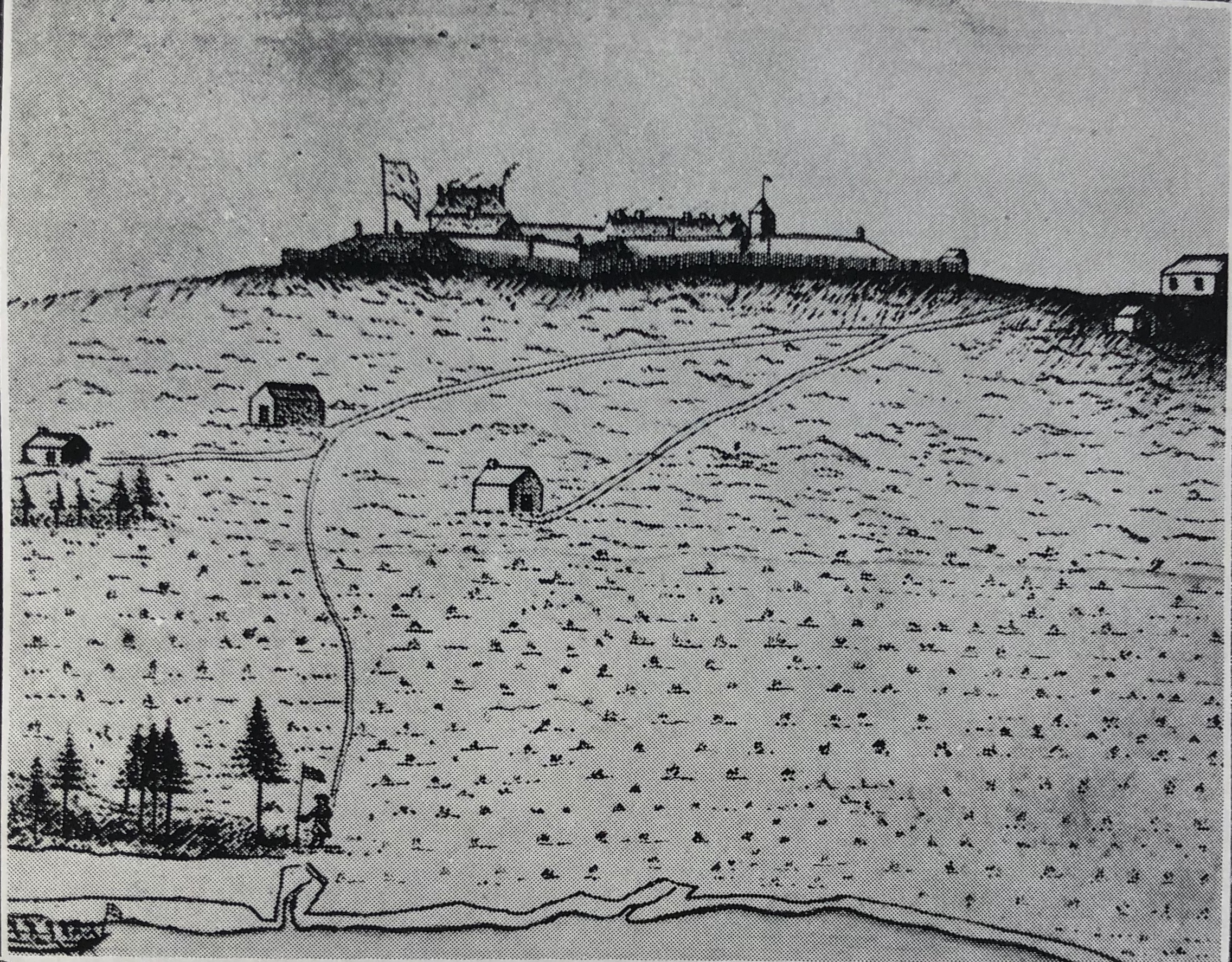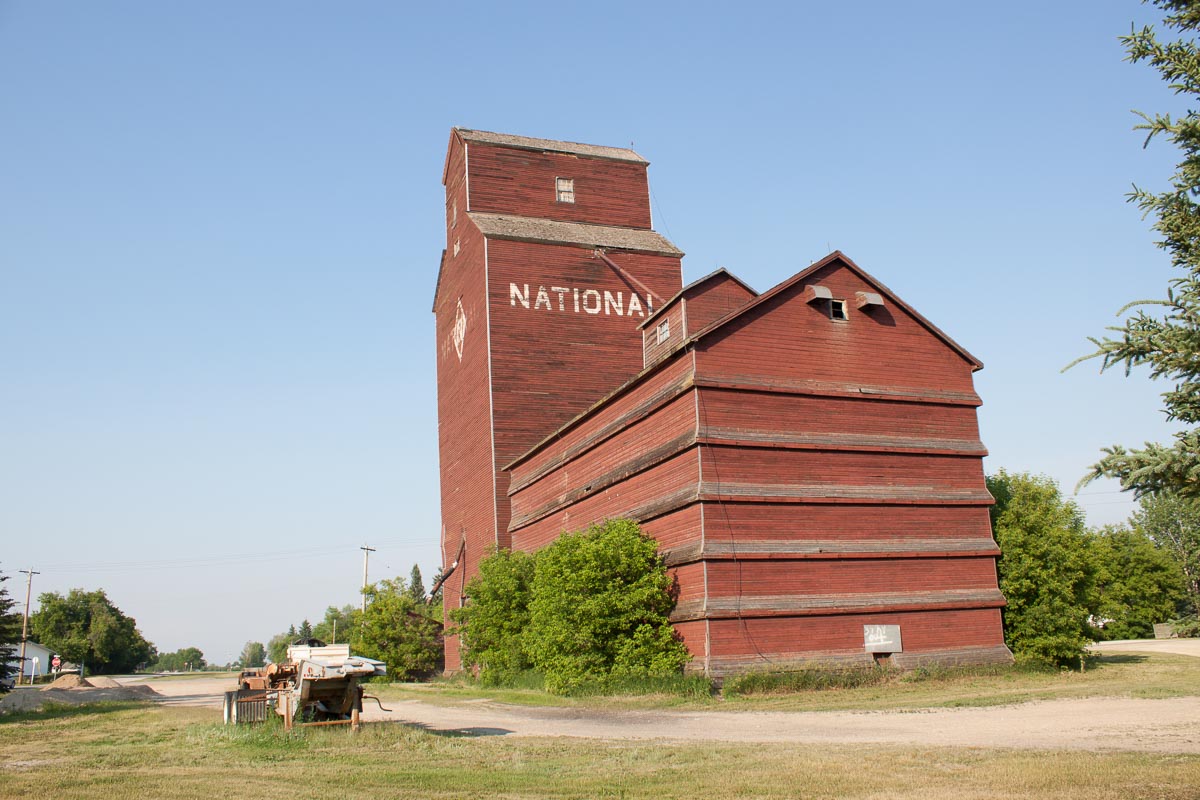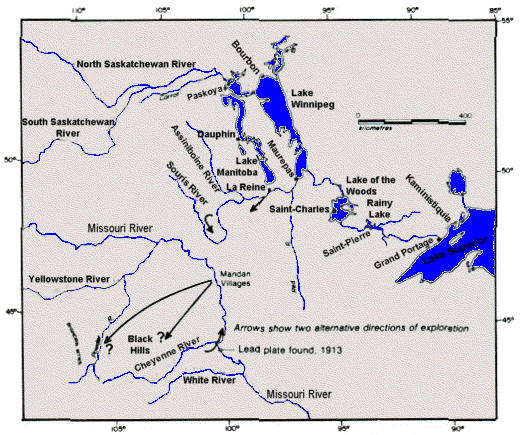|
Pierre Gaultier De La Vérendrye
Pierre Gaultier de La Vérendrye de Boumois (December 1, 1714 – September 13, 1755) was the second son of Pierre Gaultier de Varennes, sieur de La Vérendrye. An explorer and fur trader who served many years under the command of his father, he was born on Île aux Vaches, (Isle of Cows) near Sorel, Quebec, Sorel, New France. The young Pierre spent two years in the colonial regular troops as a cadet, doing garrison duty in Montreal. In 1731, when his father planned an expedition to expand the fur trade westward and at the same time search for a water route to the Western Sea, he accompanied his father and brothers Jean Baptiste de La Vérendrye, Jean Baptiste, François de La Vérendrye, François, and Louis-Joseph Gaultier de La Vérendrye, Louis-Joseph as a member of the expedition. He spent the winter at Fort Kaministiquia while his older brother Jean Baptiste and his cousin and the second in command, Christopher Dufrost de La Jemeraye, carried on to Rainy Lake and establi ... [...More Info...] [...Related Items...] OR: [Wikipedia] [Google] [Baidu] |
Parliament Building (Quebec)
The Parliament Building of Quebec (french: Hôtel du Parlement du Québec, links=no) is an eight-floor structure and is home to the National Assembly of Quebec (french: Assemblée Nationale du Québec, links=no), located in Quebec City, Quebec, Canada. The Parliament Building was designed by architect Eugène-Étienne Taché in a Second Empire style and built between 1877 and 1886, in the heart of Quebec's Parliament Hill (Quebec City), Parliament Hill. The National Assembly (or, as it was called until 1968, the Legislative Assembly of Quebec, Legislative Assembly) first met there on March 27, 1884, even as the building was fully completed only two years later, on April 8, 1886. In 1910s-1930s, the government has built several adjacent buildings to expand its office spaces, creating a parliamentary complex, of which the Parliament Building is the main edifice. The government office, is a successor of several earlier buildings, the earliest of which was built in 1620 and among which ... [...More Info...] [...Related Items...] OR: [Wikipedia] [Google] [Baidu] |
Mandan
The Mandan are a Native American tribe of the Great Plains who have lived for centuries primarily in what is now North Dakota. They are enrolled in the Three Affiliated Tribes of the Fort Berthold Reservation. About half of the Mandan still reside in the area of the reservation; the rest reside around the United States and in Canada. The Mandan historically lived along both banks of the Upper Missouri River and two of its tributaries—the Heart and Knife rivers— in present-day North and South Dakota. Speakers of Mandan, a Siouan language, they developed a settled, agrarian culture. They established permanent villages featuring large, round, earth lodges, some in diameter, surrounding a central plaza. Matrilineal families lived in the lodges. The Mandan were a great trading nation, trading especially their large corn surpluses with other tribes in exchange for bison meat and fat. Food was the primary item, but they also traded for horses, guns, and other trade goods. Popula ... [...More Info...] [...Related Items...] OR: [Wikipedia] [Google] [Baidu] |
Persons Of National Historic Significance (Canada)
A person ( : people) is a being that has certain capacities or attributes such as reason, morality, consciousness or self-consciousness, and being a part of a culturally established form of social relations such as kinship, ownership of property, or legal responsibility. The defining features of personhood and, consequently, what makes a person count as a person, differ widely among cultures and contexts. In addition to the question of personhood, of what makes a being count as a person to begin with, there are further questions about personal identity and self: both about what makes any particular person that particular person instead of another, and about what makes a person at one time the same person as they were or will be at another time despite any intervening changes. The plural form "people" is often used to refer to an entire nation or ethnic group (as in "a people"), and this was the original meaning of the word; it subsequently acquired its use as a plural form of per ... [...More Info...] [...Related Items...] OR: [Wikipedia] [Google] [Baidu] |
1755 Deaths
Events January–March * January 23 (O. S. January 12, Tatiana Day, nowadays celebrated on January 25) – Moscow University is established. * February 13 – The kingdom of Mataram on Java is divided in two, creating the sultanate of Yogyakarta and the sunanate of Surakarta. * March 12 – A steam engine is used in the American colonies for the first time as New Jersey copper mine owner Arent Schuyler installs a Newcomen atmospheric engine to pump water out of a mineshaft. * March 22 – Britain's House of Commons votes in favor of £1,000,000 of appropriations to expand the British Army and Royal Navy operations in North America. * March 26 – General Edward Braddock and 1,600 British sailors and soldiers arrive at Alexandria, Virginia on transport ships that have sailed up the Potomac River. Braddock, sent to take command of the British forces against the French in North America, commandeers taverns and private homes to feed and house the tr ... [...More Info...] [...Related Items...] OR: [Wikipedia] [Google] [Baidu] |
People Of New France
A person ( : people) is a being that has certain capacities or attributes such as reason, morality, consciousness or self-consciousness, and being a part of a culturally established form of social relations such as kinship, ownership of property, or legal responsibility. The defining features of personhood and, consequently, what makes a person count as a person, differ widely among cultures and contexts. In addition to the question of personhood, of what makes a being count as a person to begin with, there are further questions about personal identity and self: both about what makes any particular person that particular person instead of another, and about what makes a person at one time the same person as they were or will be at another time despite any intervening changes. The plural form "people" is often used to refer to an entire nation or ethnic group (as in "a people"), and this was the original meaning of the word; it subsequently acquired its use as a plural form of per ... [...More Info...] [...Related Items...] OR: [Wikipedia] [Google] [Baidu] |
Canadian Explorers
Canadians (french: Canadiens) are people identified with the country of Canada. This connection may be residential, legal, historical or cultural. For most Canadians, many (or all) of these connections exist and are collectively the source of their being ''Canadian''. Canada is a multilingual and multicultural society home to people of groups of many different ethnic, religious, and national origins, with the majority of the population made up of Old World immigrants and their descendants. Following the initial period of French and then the much larger British colonization, different waves (or peaks) of immigration and settlement of non-indigenous peoples took place over the course of nearly two centuries and continue today. Elements of Indigenous, French, British, and more recent immigrant customs, languages, and religions have combined to form the culture of Canada, and thus a Canadian identity. Canada has also been strongly influenced by its linguistic, geographic, and ec ... [...More Info...] [...Related Items...] OR: [Wikipedia] [Google] [Baidu] |
Explorers Of Canada
Exploration refers to the historical practice of discovering remote lands. It is studied by geographers and historians. Two major eras of exploration occurred in human history: one of convergence, and one of divergence. The first, covering most of ''Homo sapiens'' history, saw humans moving out of Africa, settling in new lands, and developing distinct cultures in relative isolation. Early explorers settled in Europe and Asia; 14,000 years ago, some crossed the Ice Age land bridge from Siberia to Alaska, and moved southbound to settle in the Americas. For the most part, these cultures were ignorant of each other's existence. The second period of exploration, occurring over the last 10,000 years, saw increased cross-cultural exchange through trade and exploration, and marked a new era of cultural intermingling, and more recently, convergence. Early writings about exploration date back to the 4th millennium B.C. in ancient Egypt. One of the earliest and most impactful thinkers of ... [...More Info...] [...Related Items...] OR: [Wikipedia] [Google] [Baidu] |
Fort Beauséjour
Fort Beauséjour (), renamed Fort Cumberland in 1755, is a large, five-bastioned fort on the Isthmus of Chignecto in eastern Canada, a neck of land connecting the present-day province of New Brunswick with that of Nova Scotia. The site was strategically important in Acadia, a French colony that included primarily the Maritimes, the eastern part of Quebec, and northern Maine of the later United States. The fort was built by the French from 1751 to 1752. They surrendered it to the British in 1755 after their defeat in the Battle of Fort Beauséjour, during the Seven Years' War. The British renamed the structure as Fort Cumberland. The fort was strategically important throughout the Anglo-French rivalry of 1749–63, known as the French and Indian Wars by British colonists. Less than a generation later, it was the site of the 1776 Battle of Fort Cumberland, when the British forces repulsed sympathisers of the American Revolution. Since 1920 the site has been designated as a National ... [...More Info...] [...Related Items...] OR: [Wikipedia] [Google] [Baidu] |
Winnipegosis, Manitoba
Winnipegosis is an unincorporated urban community in the Rural Municipality of Mossey River, Manitoba, Canada. It lies at the mouth of the Mossey River on Lake Winnipegosis The community was once categorized as a village, but this status was relinquished on 1 January 2015 upon its amalgamation with the RM of Mossey River. History The lake name ''Winnipegosis'', which has evolved through different spellings, came from the Cree word meaning 'Little Muddy Water', a diminutive of Winnipeg, which means 'Muddy Water'. Mossey River was spelled "Mossy" prior to 1900. Demographics In the 2021 Census of Population conducted by Statistics Canada, Winnipegosis had a population of 945 living in 388 of its 481 total private dwellings, a change of from its 2016 population of 617. With a land area of , it had a population density of in 2021. Commerce The mouth of Mossey River was the site of the original Fort Dauphin fur trading post, constructed by the son of French explorer Pier ... [...More Info...] [...Related Items...] OR: [Wikipedia] [Google] [Baidu] |
Fort Dauphin (Canada)
Fort Dauphin, was built in 1741 near Winnipegosis, Manitoba with Pierre Gaultier de La Vérendrye, the western military commander, directing construction. The area provided a post located between the Assiniboine River and the Saskatchewan River. It was named for the Dauphin prince of France. A second Fort Dauphin was built in 1767 on the north shore of Lake Dauphin, so both the fort and the lake had the same name. This fort was built by French fur traders after the era of the western military commanders. As with many of the forts of the times, they kept the same names while changing locations to facilitate trade with the First Nations and to secure better physical locations. The site at Winnipegosis was designated a National Historic Site of Canada National Historic Sites of Canada (french: Lieux historiques nationaux du Canada) are places that have been designated by the federal Minister of the Environment on the advice of the Historic Sites and Monuments Board of Canada ... [...More Info...] [...Related Items...] OR: [Wikipedia] [Google] [Baidu] |
Fort La Reine
Fort La Reine was built in 1738 and is one of the forts of the western expansion directed by Pierre Gaultier de Varennes et de La Vérendrye, first military commander in the west of what is now known as Canada. Located on the Assiniboine River where present day Portage la Prairie, Manitoba, stands, the fort served as a fur trading post. It was also the base of operations for much exploration north and west. From Fort La Reine, explorers made their way to Lake Manitoba and Lake Winnipegosis, Lake Winnipeg and the Saskatchewan River. Louis-Joseph Gaultier de La Vérendrye, the youngest La Vérendrye son, led expeditions from Fort La Reine and built the following western installations in what is now Manitoba: Fort Dauphin, Fort Bourbon, and Fort Paskoya. In 1743, the fort was also the starting point for an exploration of the upper Missouri River as far as the Yellowstone River. One old source says that the fort was burnt to the ground by the Assiniboines after the French had left ... [...More Info...] [...Related Items...] OR: [Wikipedia] [Google] [Baidu] |

.jpg)
_1938.jpg)




